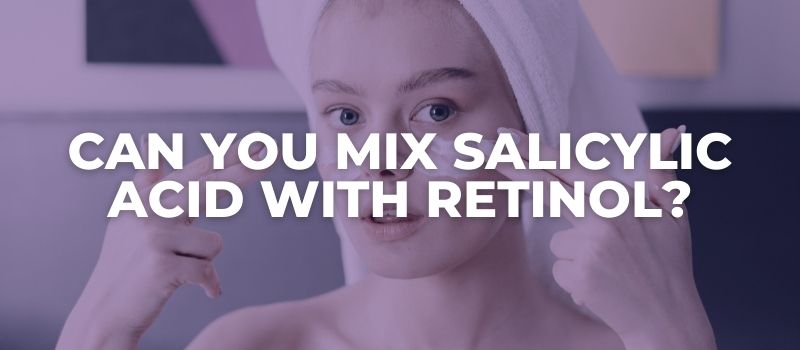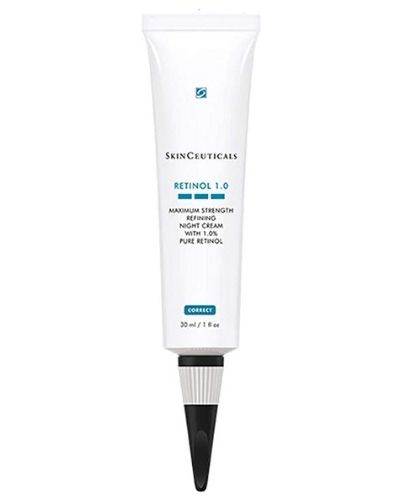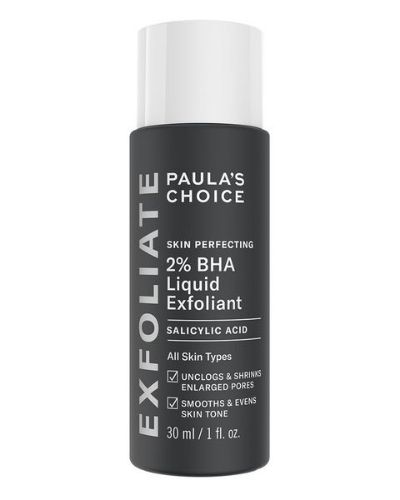There are so many ingredients in skincare products that can be mixed together to target certain skin concerns and maximize skin benefits.
However, if there is one combination that should never be introduced to the skin, it has to be the one we will talk about today.
So, to answer your question…
No, you can’t mix salicylic acid with retinol unless you want to deal with some (potentially) pretty serious consequences.
But if you want to read more about both ingredients, how they work, and understand why you can’t combine them in the same routine, continue reading.

How Does Retinol Work?

Retinol belongs to the family of retinoids, which are vitamin A derivatives.
Unlike exfoliating acids that work on the skin’s surface, retinol doesn’t remove dead skin cells from the surface of the skin; but instead, the small molecules can go deeper and encourage rapid cellular renewal from the inside out.
This will inevitably cause the dead skin cells on the surface of the skin to shed faster, which is why it can be said that retinol has an exfoliating-like action, but it’s a little bit different than regular exfoliation.
This action will not only rapidly clear out and decongest clogged pores but will also shed superficial hyperpigmentation until the skin tone is completely evened out and uniform.
Other than that, retinol can also neutralize free radicals and boost the production of elastin and collagen, which are the proteins that make the skin elastic and bouncy.
An increase in collagen and elastin production creates a “plumping” effect that reduces the appearance of fine lines, wrinkles, and enlarged pores.
Finally, retinol has also been proven to balance your skin hydration levels.
Mild exfoliating effects help to remove dead skin cells that may lead to moisture loss. This may even benefit oily skin by controlling excess production of sebum in your pores.
Some benefits of using retinol include:
- decongesting the pores
- getting rid of acne
- improving wrinkles and fine lines
- brightening hyperpigmented spots
- evening out uneven skin tone and texture
- improving sun damage
RELATED: Can You Mix Niacinamide With Retinol?
How Does Salicylic Acid Work?

Salicylic acid is a very basic ingredient with a straightforward action but can help address several skin concerns with regular use.
Salicylic acid is a BHA and an oil-soluble ingredient that can cut through the superficial skin oil and travel deeper into the pores, where it will dissolve the gunk made up of dead skin cells, white blood cells, oil, and other cellular debris, that’s causing a stiff clog.
This will, in turn, allow for our natural oil to flow freely out of the pores instead of remaining stuck inside and causing issues such as blackheads and acne.
Salicylic acid is truly an amazing ingredient; however, the catch with it is that you have to continue using it to continue seeing results as your skin is likely to come back to the same old if you stop using it for a longer period of time.
Some benefits of using salicylic acid include:
- soothing inflammation on the skin
- cutting through the surface oil and deeply cleansing congested pores
- making the pores appear smaller and clear
- clearing acne-breakouts
- dissolving blackheads
- soothing deeply inflamed cysts
Risks of Using Salicylic Acid With Retinol

While you can definitely benefit from both salicylic acid and retinol, you have to keep these two in separate routines.
Both ingredients have great skin benefits and can target multiple skin concerns at once; however, these can be terrible for the skin if mixed together.
Here are some potential side effects of using salicylic acid with retinol:
Over-exfoliation
Since both ingredients have exfoliating properties, using them together could easily lead to over-exfoliation, which is bad news for the skin.
Over-exfoliated skin has difficulty retaining moisture because the new, immature cells may give a glowy complexion, but they don’t have the optimal moisture-holding capacity as mature cells do, which is why moisture will evaporate easier.
Dryness and irritation
When moisture evaporates from the skin easier, this will leave the skin dry and irritated.
The skin may try to compensate for the dryness by producing more and more oil, which will then lead to greasy skin and eventually more clogs and more breakouts.
This means that the skin’s function is out of whack and that the skin needs to heal and go back to normal function.
RELATED: How to Get Rid of Dry & Flaky Skin?
Damaged skin barrier
When the skin doesn’t function optimally, that means that the skin’s barrier is damaged and impaired of normal function.
Damaged skin barrier typically manifests itself as being constantly irritated, red, and inflamed.
It often gets to the point where it will be painful to even wash your face with plain water due to the intense burning sensation.
Intense peeling and shedding
And last but not least, combining salicylic acid and retinol will definitely lead to intense peeling and shedding, especially around the mouth.
Both ingredients (but especially retinol) cause initial peeling and shedding, which typically lasts for a few weeks until the skin gets used to the active ingredient.
However, mixing both ingredients in the same routine can intensify this occurrence and can sometimes trigger the skin to shed for a few days without stopping.
This was my personal experience after I mixed Paula’s Choice BHA Liquid Exfoliant with my Medik8 Crystal Retinal back when I didn’t know any better.
My skin ended up peeling and shedding for a few days to the point where even a moisturizer wasn’t helping.
RELATED: Best Paula’s Choice Products for Acne.

My name is Simone and I am a certified skin specialist. I created this website to teach my readers how to take great care of their skin and I also like to occasionally share my honest opinions on skincare products I’ve tried. You can learn more about me here.
